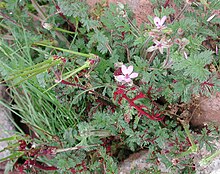Synchytrium
| Synchytrium | |
|---|---|
 |
|
| Synchytrium (prob. S. papillatum) infection of Erodium cicutarium at Lookout Mountain, Phoenix, Maricopa Co., Arizona, USA. | |
| Scientific classification | |
| Kingdom: | Fungi |
| Division: | Chytridiomycota |
| Class: | Chytridiomycetes |
| Order: | Synchytriales |
| Family: | Synchytriaceae |
| Genus: |
Synchytrium de Bary and Woronin, 1863 |
| Species | |
Synchytrium is a large genus of plant pathogens within the phylum Chytridiomycota. Species are commonly known as false rust or wart disease. Approximately 200 species are described, and all are obligate parasites of angiosperms, ferns, or mosses. Early species were mistakenly classified among the higher fungi (Ascomycota or Basidiomycota) because of their superficial similarity to the rust fungi. Anton de bary and Mikhail S. Woronin recognized the true nature of these fungi and established the genus to accommodate Synchytrium taraxci, which grows on dandelions, and S.succisae, which grows on Succisa pratensis. Synchytrium taraxci is the type of the genus. The genus has been divided into 6 subgenera based on differences in life cycles.
Members of Synchytrium are endobiotic, holocarpic, and inoperculate. This means Synchytrium species grow inside of the host cell (endobiotic), produce structures other than a zoosporangium (holocarpic), and do not release zoospores through a lid-like structure (inoperculate). Zoospores of other members of Chytridiomycota typically give rise to one zoosorangium or a polycentric thallus capable of producing many zoosporangia. In Synchytrium, the zoospore nucleus divides many times with each daughter nucleus giving rise to a zoosporangium. This produces a cluster of clonal zoosporangia, often enveloped with a membrane. This cluster is called a sorus. The zoospore can give rise to the sorus directly or it can act as a prosorus. The difference is demonstrated in the life cycle, which is discussed below.
Most species share the same initial developmental stages. The released zoospores swim until they find a suitable host and will occasionally use amoeboid movement to better orient themselves to a host plant cell. After the zoospore attaches to a host cell, a narrow germ tube forms and penetrates the host cell, which is usually an epidermal cell. An exception to this is S. minutum; it uses the stomata to enter the host plant and penetrate a sub-epidermal cell. After penetration, the zoospore cytoplasm flows into the host cell. The Synchytrium nucleus travels toward the host cell nucleus and becomes enveloped in host cyctoplasm. After this point, differences arise among Synchytrium species. Species fall into one of two broad categories: short cycled and long cycled. Short cycled species follow one of two lines of development: sori, sporangia, zoospore or resting spore, sori, zoospore. Long cycled species follow a general pathway of prosori/sori, sporangia, zoospore, resting spore, prosori/sori, sporangia, zoospore. The nuances in life cycles are used to delineate the subgenera.
...
Wikipedia
